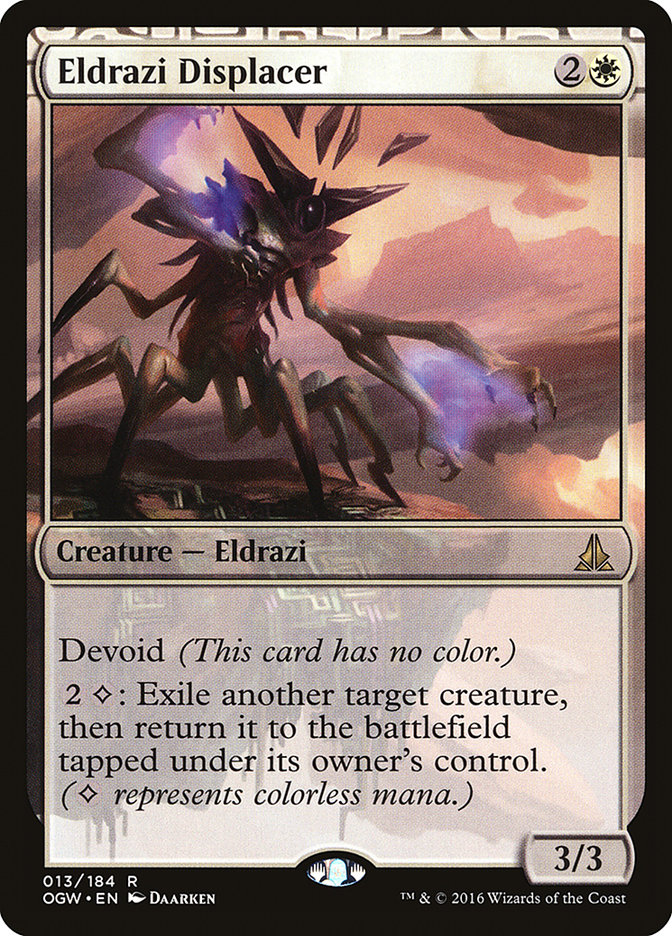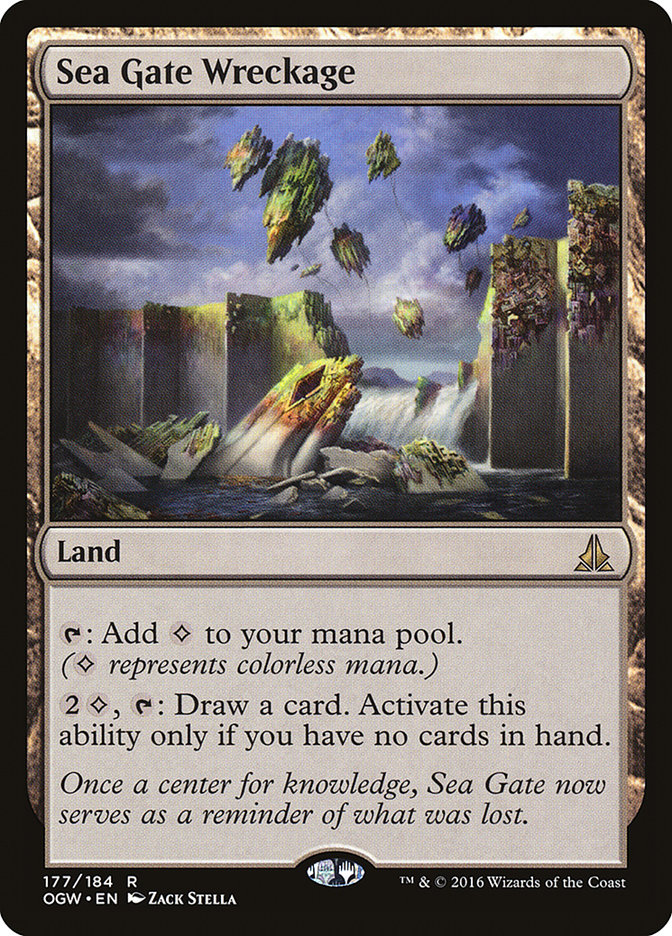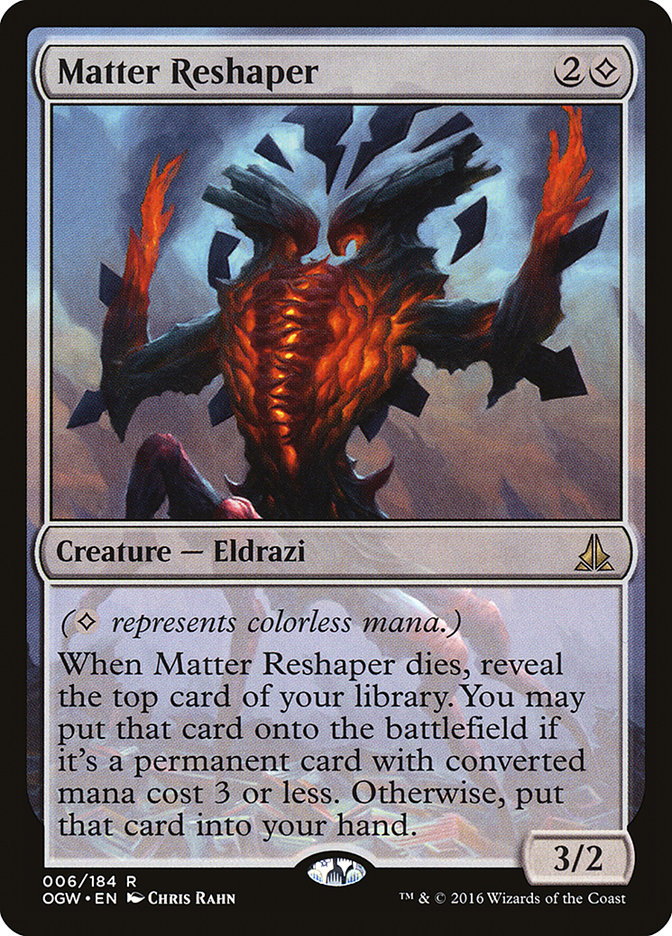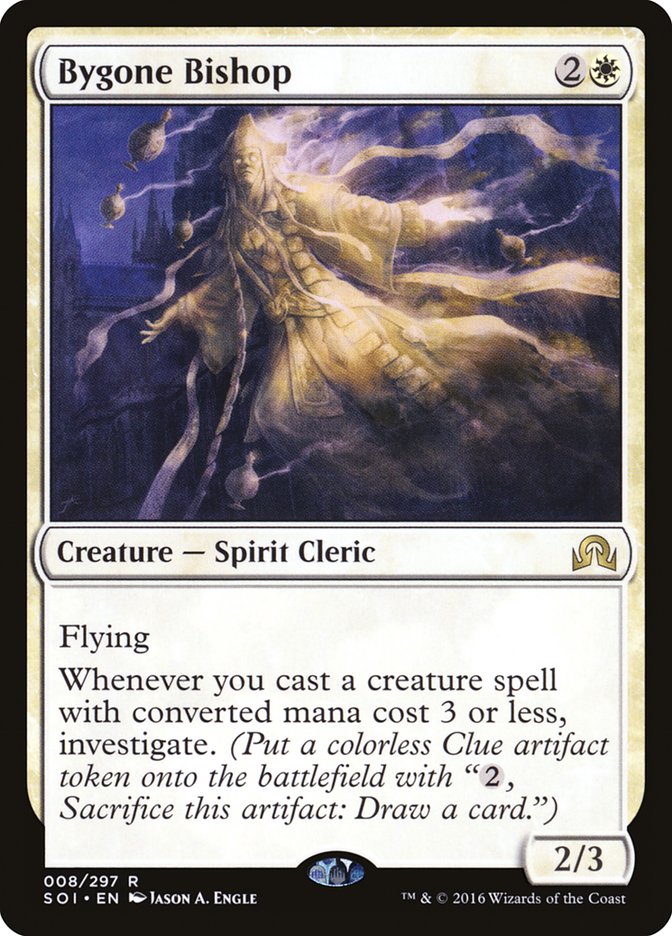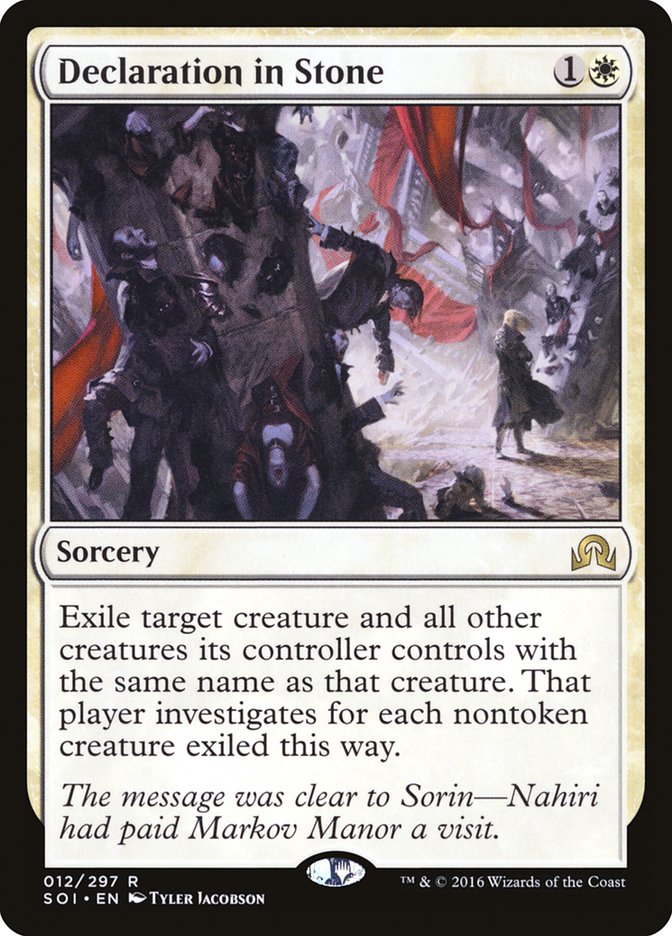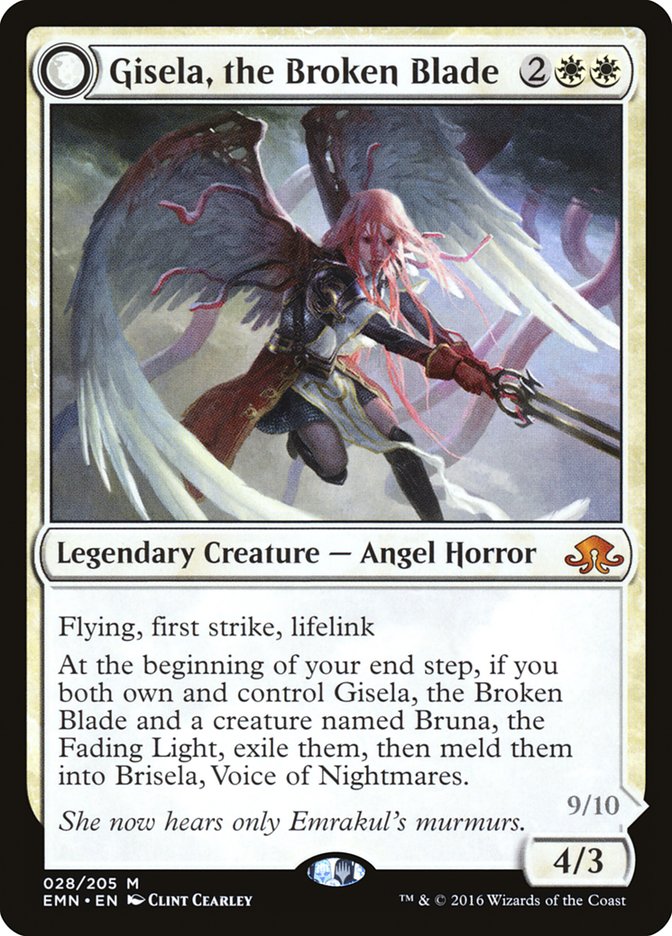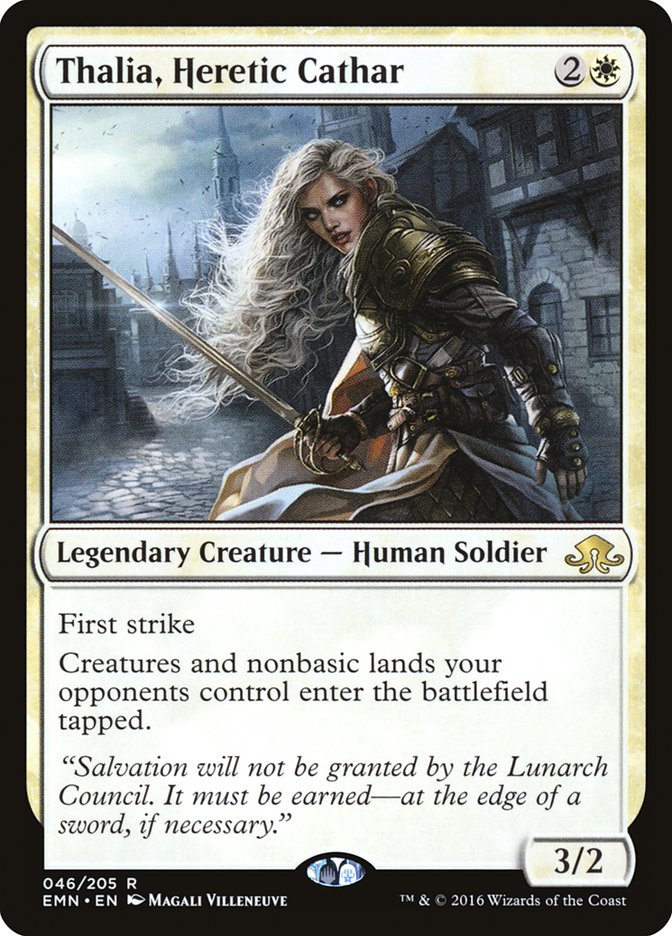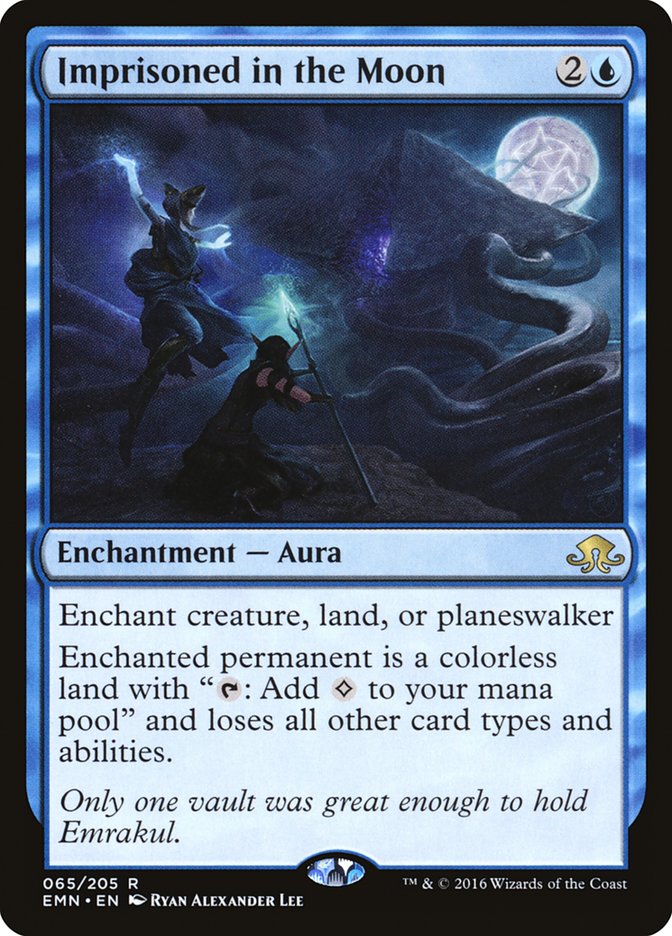With the full Eldritch Moon card list now available, everyone is poring over it to find the tech.
What will the new players be in Standard? Is there something to challenge the specter of G/W Tokens? Did Bant Company get enough to push it over the top? Will there be a ramp deck that also takes a delirium approach in order to play Emrakul, the Promised End? While the time will come for the LAB to answer those questions, I am right now asking a different question. It’s a question I ask myself every set, because the answer is of paramount import to me: what cards go into Death and Taxes?
It’s often hard for cards from new sets to break into non-rotating formats, especially Legacy. Small sets have the odds naturally more stacked against them, but that’s not to say the feat is an impossible one. Pretty much any card that makes life miserable for an opponent is under consideration, as long as it is in colors we can use of course.
Since I have not shown you lists for my Standard and Modern builds of the deck in quite a while, I will be talking about additions in the last two blocks. Some of them I have already tried, some I am waiting to test. I hope to bring you one of these every so often, because the archetype is one of my favorite ways to play Magic.
Legacy
Last time I wrote about my version of this deck, it looked like this:
Creatures (25)
- 3 Mother of Runes
- 1 Mangara of Corondor
- 3 Flickerwisp
- 4 Stoneforge Mystic
- 1 Leonin Arbiter
- 2 Mirran Crusader
- 3 Phyrexian Revoker
- 4 Thalia, Guardian of Thraben
- 1 Brimaz, King of Oreskos
- 2 Spirit of the Labyrinth
- 1 Containment Priest
Lands (23)
Spells (12)

It’s a little different now, partly because I wanted to make it fully foil and partly due to some changes with recent cards. Before we get to the current list, let’s look at what the last year or so has had to offer us. Bear in mind that in Legacy I don’t like adding the second color to the deck for things like Blood Moon, so we’re sticking to white and colorless cards.
Might as well start with the card that has found a home, at least for the time being, in my list. With eight colorless sources already in there, activating that ability should not often cause you trouble. Granted, only four of those sources end up sticking around most of the time, but we can find room for a Cavern of Souls or two without much effort.
Okay, but so what? Do we even need another three-drop in the deck? Well, yes. Three power is a big jump from two in Legacy, but that is the last reason we are playing this. That activated ability is amazing in a deck that has so many powerful enters-the-battlefield effects. Normally, to get an instant-speed Flickerwisp trigger, for example, we need Aether Vial. Not anymore!
We can also reset a Phyrexian Revoker gone astray; tutor up another Equipment with Stoneforge Mystic; kill opposing tokens; tap down blockers; fend off an Emrakul, the Aeons Torn; and of course work our magic with Mangara of Corondor. Possibly the most fun interaction is with Containment Priest, where the ability just permanently exiles creatures. That is even more powerful in the mirror.
One other thing that comes up from time to time is that you can dodge things like Dread of Night, Mother of Runes, and anything that hates out white creatures. This can often come up in the mirror match or against decks that come ready for us (which is generally sad times) and is not an interaction many people are expecting. Great fun.
I am seeing this guy cropping up a lot in sideboards, but I am not sure when he’s good. Four mana is often tough to reach, and against decks like Miracles where you really want to keep a Thalia on the battlefield, he’s often going to be five mana. We’re also playing a format where both Force of Will and Swords to Plowshares are prominently played, and both take care of Gideon for an embarrassingly small amount of mana.
The card is good. I am not arguing that. If you are in a game state somehow where you can continuously pump out 2/2 tokens, then he’s very difficult to remove in the format. Really we’re looking at multiple burn spells, Council’s Judgment, and Maelstrom Pulse as common removal that can get a four-loyalty Gideon off the battlefield, and if at any point you are able to plus him and attack, he hits very hard.
I’ve had it played against me and it did almost nothing before getting hit with a Swords to Plowshares. It’s an idea worth exploring, once I figure out just where he comes in from the sideboard.
The text on this card is too good for it to be horrible, and Legacy is the only place where we have very powerful Equipment and consistent ways to find it and get it on the battlefield. The power and toughness boost is solid when you are in a racing situation, but the real kicker here is the ability to draw cards when your equipped creatures die. That doesn’t come up a great deal in Legacy, with Swords to Plowshares and Terminus both being regularly played, but some decks do still actually kill your creatures.
Death and Taxes can often be left with an empty hand, so the ability to restock will help you keep the cards flowing later in the game when a key removal spell on your opponent can be enough to turn the tide. Probably best out of the sideboard against the likes of Shardless Sultai, but one I am excited to try out.
As I said above, empty hands are all too real for the deck. Although it’s expensive to get going, I can foresee a world where we want to be running this. Miracles springs to mind, as Wasteland loses some points against that deck and we’re more likely to have the lands in play to activate. It also has the added bonus of helping us activate Eldrazi Displacer.
One caveat: although we are a mono-color deck and we have very few activated abilities (and none that require white mana), we do need to bear in mind that having too many lands that do not tap for white mana or that get blown up by Wasteland can be a huge hindrance. Ten Plains is likely the minimum I would want.
I had someone ask me to include this card in my article because they had heard a lot about it being good. This won’t take long: No. Do not do this. Although it helps you go very wide, it does nothing to shore up weaknesses to things like Sulfur Elemental, Golgari Charm, or Dread of Night. The only thing it does is let you apply pressure without further committing to the battlefield, which can be helpful against Miracles. In a format as diverse as Legacy though, I am loath to add a card to the sideboard that only has applications against one deck. Maybe if it gave a bigger power/toughness boost…
This is the one card that makes me want to play as many colorless sources as we can cram in the deck. My current list has exactly five cards that are misses on the death trigger, though that does not include duplicating a Thalia or Karakas. It’s another three-power body that we can attack with freely, since it is guaranteed to replace itself.
Whether or not we can reliably cast it is up for debate. Aether Vial helps, but relying on it is dangerous. It’s on my list of cards to test, and although I can certainly see it being excellent, I do worry that the combination of an awkward mana requirement and the aforementioned non-killing removal will make me a sad panda.
It’s not out of the question, but in a deck that never actually wants to cast its creatures, the triggered ability on the Bishop is less impressive. I do like having another flying threat and drawing cards is rarely a bad thing, but it’s unclear just how often we will get to actually do that. One to keep your eye on, but ultimately just isn’t quite good enough I think.
It’s the best white removal spell in many years, and I think it actually has applications in the format. Miracles gives us trouble because, among other things, we have no good answer to a resolved Entreat the Angels. Although Ratchet Bomb is my answer of choice, Declaration in Stone is possibly better in some situations. Miracles decks have been known to run Stony Silence from time to time, which of course is disastrous if we’re relying on Ratchet Bomb. It’s similarly good against Storm decks that have to beat you with Empty the Warrens because you have managed to stick a Leyline of Sanctity.
Declaration also avoids giving our opponent life, a drawback on Swords to Plowshares that is often insignificant yet is anything but against a Marit Lage token, for example. Clearing out multiple Tarmogoyfs or Elemental tokens from a Young Pyromancer is also a plus. It’s not in my sideboard yet, but keep it in mind if your local meta makes it a good call.
I wish. I really, truly wish. I have often thought we should be looking to get more lifelink into the deck, and Gisela is definitely a kitchen sink-style way to do that. Why am I playing her over Linvala, Keeper of Silence, though? Sure, Gisela gains a lot of life and is nigh-impossible to block or race, but “just a good value creature” is a role with limited slots in a deck that is built to stress our opponent’s resources as much as possible while still being able to attack their life total. Gisela is a great finisher, but at four mana I need more from her. Trust me, I am sad too.
I think everyone knows that this is the most likely card in Eldritch Moon to see play in the archetype. I am not about to argue with that, but I do think we need to temper our expectations somewhat. She’s good, the art is beautiful, but she does cost three and that slot already has a glut of great options.
The challenge then is what we cut, not whether or not she belongs. I typically have three to four slots in my list that are somewhat flexible, and they are usually filled with singletons. I think two or three copies of new Thalia will be best, although in Legacy we get many more nonbasic lands than in any other format. I wrote a lot more about Thalia last week and it all still stands, so check that out for more on her applications here.
Here’s my current Legacy list as of Shadows over Innistrad:
Creatures (25)
- 4 Mother of Runes
- 1 Mangara of Corondor
- 3 Flickerwisp
- 4 Stoneforge Mystic
- 2 Mirran Crusader
- 3 Phyrexian Revoker
- 4 Thalia, Guardian of Thraben
- 1 Brimaz, King of Oreskos
- 2 Spirit of the Labyrinth
- 1 Eldrazi Displacer
Lands (11)
Spells (24)

The only major change I didn’t discuss is the substitution of Hallowed Moonlight for Containment Priest. Basically I felt the Sneak and Show matchup was already great without Containment Priest, which hampers a lot of our own gameplan with Aether Vial and flickering our own creatures. Hallowed Moonlight not only avoids that, it also draws a card and can counter things like Entreat the Angels, Batterskull’s living weapon trigger, and Empty the Warrens. Containment Priest specifically says non-token, and although it beats in for two a turn I think the tradeoff is worth it.
What’s that? Oh, yes, okay. Hallowed Moonlight is available in foil and Containment Priest isn’t. That only played a small role in the decision. Honestly.
Modern
With a smaller card pool comes a call for more flexibility, and in Modern I play W/U Death and Taxes. The blue adds so many high-value creatures that I cannot in good faith ignore it. Moreso than in any other format, these evaluations are a team effort with contributions from friends and fellow judges Alex Mullins, Ask a Judge’s own Paul Baranay, and Trevor Gulley.
Although I am very aware of the existence and power level of the W/B Eldrazi and Taxes deck, I have not played it and so cannot really speak to the power of any of the new(-ish) cards in that archetype. I will instead be focusing exclusively on the W/U build, the last version of which is below.
Creatures (30)
- 2 Meddling Mage
- 1 Venser, Shaper Savant
- 1 Kitchen Finks
- 4 Flickerwisp
- 4 Leonin Arbiter
- 1 Mirran Crusader
- 1 Phyrexian Metamorph
- 2 Blade Splicer
- 1 Fiend Hunter
- 3 Thalia, Guardian of Thraben
- 3 Restoration Angel
- 1 Lyev Skyknight
- 1 Lavinia of the Tenth
- 3 Reflector Mage
- 2 Eldrazi Displacer
Lands (22)
Spells (8)

That version had real mana issues and a fair few flex spots, as well as an undesirable weakness to both Blood Moon and our own Leonin Arbiters. Have we found enough to fix that? Will Reflector Mage be good enough? Is Eldrazi Displacer good enough to keep around?
To avoid writing the same stuff twice, I have left out any cards that have the same reasoning in Modern as they do in Legacy.
As will be the case with a few of these cards, everything I said about this card in Legacy holds true here. Another wrinkle we have to consider in Modern is that Lightning Bolt sees even more play than it does in Legacy, weakening this somewhat. Even less likely to break through here I think.
If giving the opponent life is sometimes a rocky proposition in Legacy, giving them a basic land can be even worse in Modern. Path to Exile might do a decent impression of the best removal spell ever when we have Leonin Arbiter on the battlefield, but without it we could be undoing a lot of our hard work. Declaration has none of those issues, and the extra mana in the casting cost is less of a concern here than in Legacy. I am giving serious thought to a straight replacement here, but zero Path to Exile feels like it cannot be right.
I am torn on the value of this card in Modern. There is no doubt that it has a bunch of powerful interactions, but unlike in Legacy our colorless lands are not as powerful. I think I went overboard on colorless sources in the build above, but the fact is that we are stretching a manabase that needs to be consistent in order to play a card that basically makes a good position even better. I definitely don’t want more than two, and one might be correct.
Is Gideon better in Modern than Legacy? It’s debatable, especially in this world of Jeskai Nahiri and the subsequent increase in anti-planeswalker cards. Path to Exile is just as clean an answer to Gideon as Swords to Plowshares is, and although it is significantly easier to reach four mana in Modern, we still need to consider that Dismember is a card that sees substantial Modern play. Is he better than Elspeth, Knight-Errant? I am even less sure here. Jumping a Mirran Crusader will often end the game. I am open to trying it, but I’m going in pessimistic.
The truth. It’s been my experience that the second Reflector Mage often wins you the game, and when that can be done at instant speed with Aether Vial or Eldrazi Displacer, the impact is even greater. This card is way, way better than its rarity and stats suggest, and even if you knew it was powerful when you read it, you underestimated it. In hindsight, I should not have been surprised that its power would translate to Modern.
I am very intrigued by the potential of this card. It can turn virtually anything into a harmless mana producer that can also be destroyed by Tectonic Edge and Ghost Quarter. Let that sink in: we can put this on a Karn Liberated or Ugin, the Spirit Dragon and then blow it up with Tectonic Edge. Yes, I know, I’m excited too. It’s probably a sideboard card but I am definitely going to test in my Tron-heavy metagame.
I’m going to tell you again that you should check the Legacy write-up above, but I’d add that her effectiveness in Modern is different. Although the ability to win the Wasteland war isn’t applicable, Modern is a slower format in general, which means slowing the opponent down is even more effective. Fetchlands are everywhere, Kiki-Chord is a big player in the format, and Tron falls a turn behind. Not a bad set of bonuses!
I am mostly sure that this card is off-the-chain good, but a little part of me is pausing on the fact that the opponent can more or less choose when they get the spell back. With some spells, like countermagic or the second half of a combo, that’s not especially good. In other cases, like with Scapeshift for example, it still wins the game. We’re almost definitely still playing it, but bear in mind that warning: this can backfire horribly.
Comments from Last Week
Chad Raffield offered this decklist:
Creatures (2)
Planeswalkers (12)
Lands (16)
Spells (30)

I see what you did there. I see it and I am terrified of it. My worry is that, without the Oath of Nissa, we are just a bad Tron deck with no way to stay alive against the faster decks. Wurmcoil Engine and Oblivion Stone, which you seem to have cut to the sideboard for the planeswalker package, fill that role in the traditional version. We’re also not getting a tremendous amount of value out of Doubling Season without a way to find it or Jace, Architect of Thought to just end the game on the spot. There’s a plan here, but I think it needs some refining.
That’s all from the LAB this week, folks. As always, thanks for stopping by. Did I forget any cards that you think will be a player in Death and Taxes in the coming months? Please let me know! Input is always welcome.
Until next time…Brew On!


